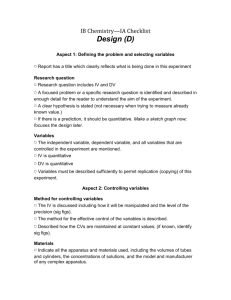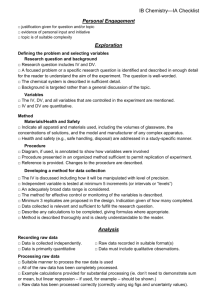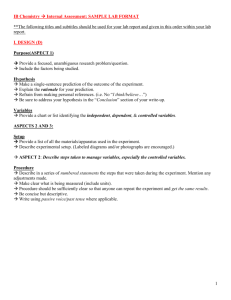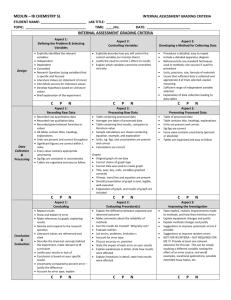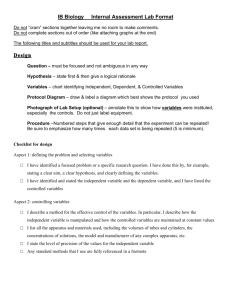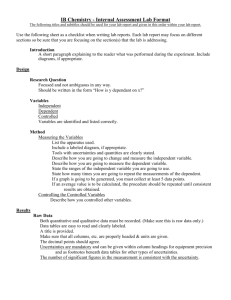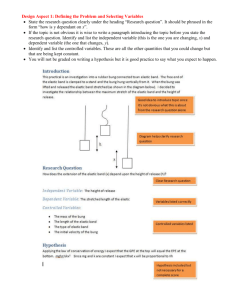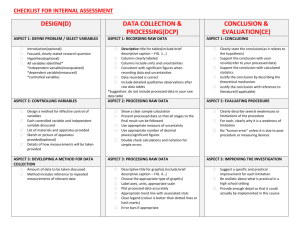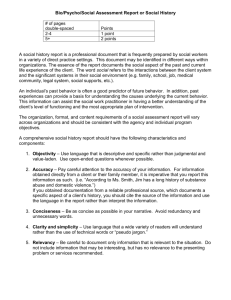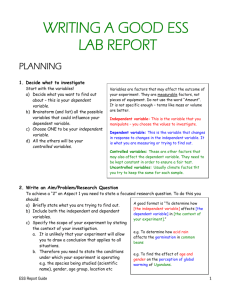Data Collection & Processing Checklist
advertisement
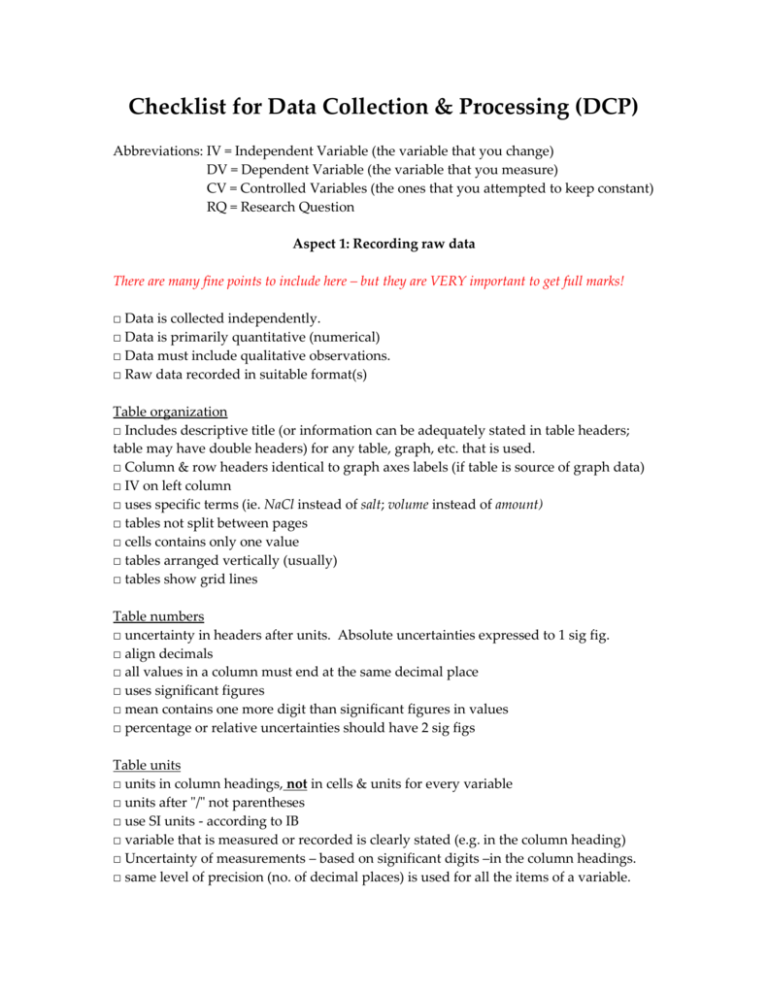
Checklist for Data Collection & Processing (DCP) Abbreviations: IV = Independent Variable (the variable that you change) DV = Dependent Variable (the variable that you measure) CV = Controlled Variables (the ones that you attempted to keep constant) RQ = Research Question Aspect 1: Recording raw data There are many fine points to include here – but they are VERY important to get full marks! □ Data is collected independently. □ Data is primarily quantitative (numerical) □ Data must include qualitative observations. □ Raw data recorded in suitable format(s) Table organization □ Includes descriptive title (or information can be adequately stated in table headers; table may have double headers) for any table, graph, etc. that is used. □ Column & row headers identical to graph axes labels (if table is source of graph data) □ IV on left column □ uses specific terms (ie. NaCl instead of salt; volume instead of amount) □ tables not split between pages □ cells contains only one value □ tables arranged vertically (usually) □ tables show grid lines Table numbers □ uncertainty in headers after units. Absolute uncertainties expressed to 1 sig fig. □ align decimals □ all values in a column must end at the same decimal place □ uses significant figures □ mean contains one more digit than significant figures in values □ percentage or relative uncertainties should have 2 sig figs Table units □ units in column headings, not in cells & units for every variable □ units after "/" not parentheses □ use SI units - according to IB □ variable that is measured or recorded is clearly stated (e.g. in the column heading) □ Uncertainty of measurements – based on significant digits –in the column headings. □ same level of precision (no. of decimal places) is used for all the items of a variable. Aspect 2: processing raw data □ Suitable manner to process the raw data is used (this may involve mathematical processing, statistical analysis, or transforming the data into a suitable graphical representation). □ All of the raw data has been completely processed. □ Example calculations provided for substantial processing (i.e. you don’t need to demonstrate sum, mean or standard deviation, but linear regression – if used, for example – should be shown). □ The raw data has been processed correctly (correctly using significant figures and uncertainty values). Aspect 3: presenting processed data □ Suitable format in which to present the processed data is used. □ There are clear headings for all tables □ There are clear titles for all graphs □ Any graphs have appropriate scales, labelled axes with units and accurately plotted data points with a suitable best-fit line or curve if necessary. □ All the processing stages up to the final result can be followed easily (explanations are clear where necessary). □ The final results are shown expressed to the correct number of significant figures. □ The uncertainties and errors of raw data have been taken into account and the work toward this end is shown. (For addition and subtraction, add absolute uncertainties. For multiplication and division, add relative or percentage uncertainties.) Graphing □ Graph data sourced from single table □ Column & row headings same as graph axes □ Include simple title like "NaCl concentration vs. transmittance" □ Graph is large (whole page is ideal) □ Simple scale (usually 1,2 or 5 times a multiple/power of 10) □ [scale does not have to start at zero] Graphing both axes □ IV on X-axis, DV on Y-axis (even if it is time!) □ Labels □ Units □ Uncertainty (after units, like: mass / g / ± 0.01g ) □ Quantitative variable □ Intervals proportional □ SI units (according to IB) Checklist for Conclusion & Evaluation (CE) Aspect 1: Concluding Conclusion □ Is there a clear pattern in your processed data? □ A conclusion, which is based on a reasonable interpretation of the data, is made. Different graphs are compared or trends in graphs are made explicit. If any hypotheses are being tested, it is stated whether the data supports these hypotheses. □ Actual processed data used in conclusion (e.g. quote your data!) □ A justification is given for my conclusion. Reasons for the observed trends in data are written explicitly. Experimental groups are compared with control groups. □ If an already known and accepted value is being measured, values have been compared with that in a textbook or other reference, in order to assess the validity of the result. Percentage error is mentioned in this case. □ Any literature/references used is fully referenced. Aspect 2: Evaluating procedure Evaluation □ The design and method of the investigation have been evaluated (including discussion of the replicates and sample size used). The precision of the study is evaluated. □ Measurement errors are analyzed to evaluate the accuracy of measurements. □ Instrument errors are analyzed (including possibility of calibration errors - when appropriate) to evaluate the accuracy of measurements. □ Random error is evaluated. Random variations in samples that are uncontrollable should be mentioned. □ Each error is explained thoroughly and clearly: How might each have impacted the results? Aspect 3: Improving the investigation Improvements □ All improvements are based on the weaknesses and limitations identified in aspect 2. The specific errors mentioned are the ones corrected. □ Modifications to the experimental technique are appropriate to correct errors mentioned. □ All proposed modifications are realistic (they are actually variables that can be controlled). □ All proposed modifications are clearly explained. Authenticity and academic integrity □ All sources of information have been cited in-text □ All sources have been included in the correct order in the bibliography □ Citation is consistent and correct □ Student has shown teacher maximum of one draft and has submitted second draft for assessment.
